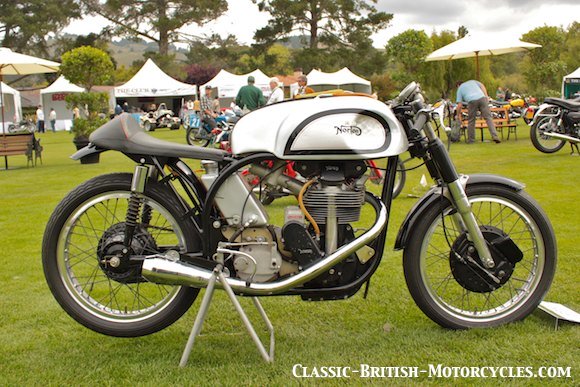1962 Norton Manx
1962 NORTON MANX BACKGROUND
The Norton Manx was developed in 1937, in both SOHC and DOHC form, to compete in and win the Isle of Man TT. Before fully developed, World War II intervened, and production of the Manx was delayed until 1946. The Manx quickly gained a reputation for its speed and reliability, allowing it to dominate the motorcycle Grand Prix racing and the Isle of Man TT for decades.

1962 NORTON MANX DESIGN
The Manx engine has an aluminum alloy cylinder block and head with a single overhead camshaft (SOHC) driven by a vertical shaft and bevel gears. They were hand assembled engines. The 1948 Norton Manx was the first to benefit from telescopic front forks and massive twin leading shoe (TLS) front brakes. 1949 was the first year for the Norton Manx Grand Prix models, purpose-built for road racing, and in 1950, they introduced the legendary “Featherbed Frame”. It was made of all-welded steel tubing instead of the common practice of heavy cast iron brazed lugs. It made the bike lighter, and they handled like nothing else on the market. The 1953 Norton Manx was the last to use the ‘long-stroke’ engine, although it was a year of transition, so some early 1953s were the last of the long strokes, while the bulk of the model year’s production was dedicated to the new short stroke setup. This de-stroking took a major engine rework using a shorter stroke (86mm) and larger bore (85.6mm) making the ratio nearly “square”, and it would remain as such for the remainder of its production life in 1962.

1962 NORTON MANX – THE LAST MANX
Alas the world was changing. Parent company AMC wanted out of racing, trying to focus everything on its ailing sales. At the same time, Lucas (Prince of Darkness) who supplied nearly all electrical components to the British motorcycle industry at large had announced that it would cease production of its magnetos in 1963. They were moving wholesale into points and coils. Converting the ancient Manx over to a the system would have been cost-prohibitive, so Norton pulled the plug on the Manx in 1962, and without a direct replacement. All their focus was now on twins. However, the still-very-fast Manx had become the backbone of low-bucks privateer racers who continued to field them for years. Then in the 1970s a huge vintage-racing movement started that has grown since, and Norton Manx’s have been a big part of that. A true timeless classic.
1962 Norton Manx SPECIFICATIONS
|
Engine type Displacement Bore & Stroke Compression Carburetor Ignition Engine Output Primary Drive Clutch Gearbox Final Drive Frame type Wheelbase Suspension, F Suspension, R Brake, F Brake, R Weight Top Speed |
Air-cooled DOHC single 498cc 86mm X 85.6mm na Amal GP Lucas magneto 54 bhp @ 7200 rpm Chain Multi-plate, wet 4-speed, R-foot shift Chain Featherbed 56.0″ Telescopic, oil damped Swing arm, 2 dampers TLS 8″ drum SLS 7″ drum 310 lbs / 180 kg 140 mph / 230 kph |


